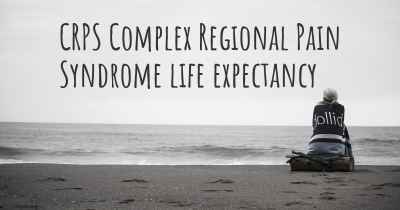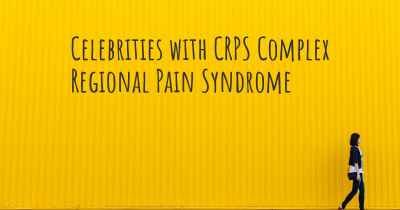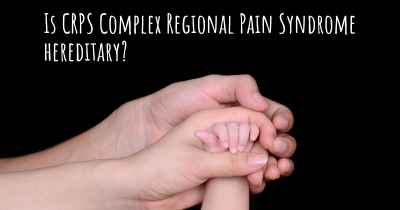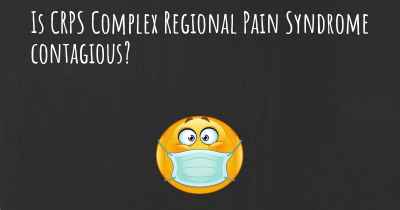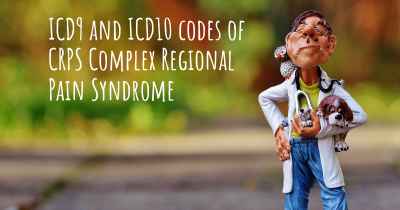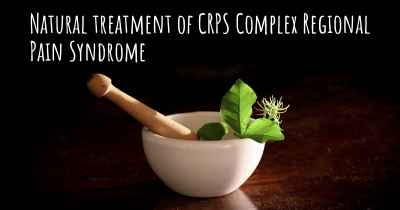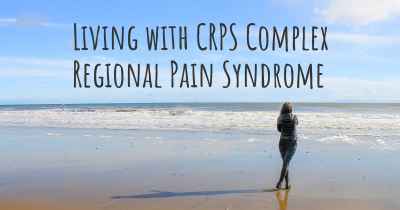2
What are the best treatments for CRPS Complex Regional Pain Syndrome?
See the best treatments for CRPS Complex Regional Pain Syndrome here
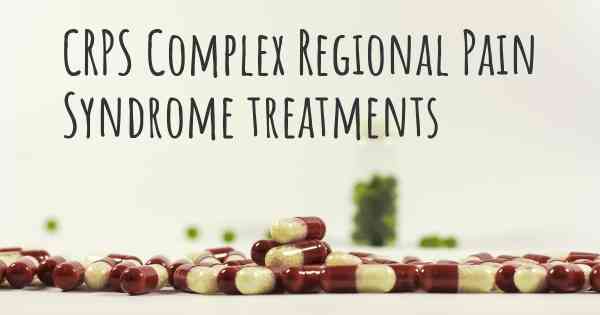
Depends, they all work for different for different people here's a list of different ones though.
-ketamine infusion
-HBOT therapy
-epidural
-aqua therapy/physical therapy
-steroids
-nerve blocks
-ketamine infusion
-HBOT therapy
-epidural
-aqua therapy/physical therapy
-steroids
-nerve blocks
Posted Apr 20, 2017 by Chloe 1000
Treatment should be discussed with a qualified professional as there are varying types of this disease. What has worked for me has been: Constant low impact exercise, Gabapentin, Cymbalta, Naltrexone, b12, Vitamin D, Alpha Lipoid Acid, L Arginine and meditation.
Posted May 9, 2017 by Jon 1100
There are several treatments but there is not a select treatment that works well for everyone or almost everyone. With CRPS, each person must use trial and error until something might help. I use a certain medication along with 2 other to get any relief. However! I'm never completely clear of pain.
Posted May 18, 2017 by Geniva 300
Nerve blocks, Neuromodulation system such as a DRG implant, ketamine injections, medications such as lyrica or gabapentin (neurontin)
Posted May 24, 2017 by Stevi 600
Medication like savella has been the best treatment for me, but every person is different.
Posted Aug 17, 2017 by Chelsea 2335
Meditation
Stress therapy
CBT
Physiotherapy if it does not aggrevate the limb
An understanding of the disease
Keeping occupied with activities that are pleasant
Having support
Stress therapy
CBT
Physiotherapy if it does not aggrevate the limb
An understanding of the disease
Keeping occupied with activities that are pleasant
Having support
Posted Sep 6, 2017 by [email protected] 5060
I have been on about every pain med there is and it's funny but Suboxone has been the best at controlling my pain.
Posted Sep 11, 2017 by Craig 1600
Ive not found any treatment really helped. Tried various medications, physiotherapy, massage, heat, infared, acupuncture.
Now fitted with a nevro spinal cord stimulator and starting to get some relief at last.
Now fitted with a nevro spinal cord stimulator and starting to get some relief at last.
Posted Sep 13, 2017 by Andy 3550
I would say the best treatment is Calmare Therapy.
Others would be physical therapy, this can include hydro therapy, and a good medication regime that suits you and your needs. An anti inflamitory diet can also be of assistance.
Others would be physical therapy, this can include hydro therapy, and a good medication regime that suits you and your needs. An anti inflamitory diet can also be of assistance.
Posted Sep 13, 2017 by Chanelle 1250
The term "best" is highly subjective and because people are unique in the way they experience the pain of CRPS, their response to treatment varies. Most start with medication including pain drugs, most often opioids (i.e. fentanyl, hydrocodone, oxycodone, etc.), and nerve agents (i.e. gabapentin, Lyrica). Antidepressant medications (i.e. nortriptyline), beta-blockers (i.e., metoprolol), and low dose Naltrexone (which helps with inflammation) have side effects of reducing pain. CBD oil and medical cannabis has been helpful to many with CRPS. Some people find essential oils, cranial-sacral massage, Mindfulness meditation and other alternative therapies to be helpful. Nerve blocks might be attempted at the sight of the pain or in the spine. Spinal cord stimulators and DRG (dorsal root ganglion) stimulators are widely used to interrupt the pain signal to and from the brain. Ketamine infusions and neridronate infusions are frequently used when other treatments are ineffective. Stem cell therapy is not generally helpful for CRPS, but patients often have nerve damage in addition to CRPS, and adult stem cells can be injected at the site with the goal of regenerating nerve cells.
Posted Sep 15, 2017 by DrLisa 3750
Mirror box works sometimes, gemtle massage and stretching but most importantly is the mental determination not to let CRPS rule your life.
Posted Sep 19, 2017 by Alex 2550
Everyone with this disease responds differently to different treatments that is why it has been so hard for Doctors to treat. Physical therapy to keep the affected limb moving in combination with nerve blocks and different medications make living with the disease bearable.
Posted Oct 8, 2017 by Valerie 1500
Physical therapy, sympathetic nerve blocks, spinal cord stimulators (DRG only — the others don’t work!)
Posted Nov 11, 2017 by Robbie 2000
I don’t know the best but I know what helps me. Ketamine infusions help me greatly! I was able to wear shoes and pants for the first time in years cause of the pain. The pain was there but it helped a lot. It also helped with my depression. Spinal cord stimulator has made a difference in my pain. It wasn’t as much as I was hoping for but everything helps! Certain medications help take the edge of the pain down but non take it away. Heating pads are my life saviors all year long.
But there are people that have luck with other things. Nerve blocks, diet, meditation, exercise and numerous others.
But there are people that have luck with other things. Nerve blocks, diet, meditation, exercise and numerous others.
Posted Nov 11, 2017 by Joey7807 1000
Best treatments are pain management, therapies / physical, Aqua, massage therapies are great . Acupuncture is a great tool as well.
Posted Nov 11, 2017 by Aj 2000
These vary from person to person based on location of disease. Insurance does not pay for many of the new treatments because they are not FDA approved treatments for CRPS...there aren't any. Nerve medications, sympathetic nerve blocks, anyianxiety medications, sleeping agents, spinal cord simulators, ketamine (oral or infusions), medical marijuana and neridronate.
Posted Nov 12, 2017 by Shanna 5000
There are no best treatments. Every person affected with CRPS might respond differently to specific treatments. Everyone has to find what is right for them.
I can't explain diets or natural treatments. I don't believe either of them has any affect on CRPS.
I can't explain diets or natural treatments. I don't believe either of them has any affect on CRPS.
Posted Nov 12, 2017 by ladyff1481 2050
There are a few meds that work on crps some work for some and some don't but you and your doctor need to find what works for you.
Posted Nov 13, 2017 by James 800
Pain management! Get yourself to a pain clinic if you can. There they treat the whole patient. Ì receive physio therapy with graded motor imagery exercises, occupational therapy, psychotherapy and hydrotherapy. You will also have access to a social worker and vocational therapist for the other aspects of life.
Posted Nov 13, 2017 by Thea 3150
For me, therapy and Pain Management, including Stellate Ganglion blocks, gabapentin, compound cream
Posted May 15, 2018 by Tammy 800
Medication, physiotherapy, mirror therapy, nerve blocks
Posted May 30, 2018 by Passwort123 700
Ketamine Infusion really helped. Then it stopped after 4th one.
Pool with temperatures about 92?.....soft flowing water.
Medication stopped for me after years of using them.
Pool with temperatures about 92?.....soft flowing water.
Medication stopped for me after years of using them.
Posted May 31, 2018 by Marcia 500
CBT, mindfulness ,Understanding the condition, having a great multi disciplinary team.
Posted Oct 25, 2018 by Misty 2100
For me...pain management. I use fentanyl and muscle relaxers. I have tried many other methods with no relief. Having the pain down to a tolerable level I am able to exercise. I need that for my mind as well as my body. I take one to two baths a day.
Posted Nov 1, 2018 by Judy 3000
SCS work well in relieving some pain. Pain blocks work as well for a short period. Anti-inflammatories help as well. Pain medications.
Posted Jan 5, 2019 by Cynthia 4000
I am on anti sezuires meds that help keep the hypersensitive of skin at minimal and lyrica for muscle/burning aches, and anti inflammation meds
And meds for sleep
And have a spinal cord stimulator implant
And meds for sleep
And have a spinal cord stimulator implant
Posted Jan 16, 2021 by Patricia 3050
I believe it is best for patients with complex regional pain syndrome to find a pain specialist who has worked with patients with this same diagnoses for treatment.
Posted Mar 29, 2021 by Sage0920 2000
Management. Sadly this cruel condition can and does cause amputation. My symptoms initially were pain completely.out of proportion to the injury sustained. On the McGill scalebof pain which tops at 50. CRPS can reach 42 or higher. Far worse than some types of cancer and definitely worse than child birth.
Posted Nov 3, 2022 by Heather 5020
